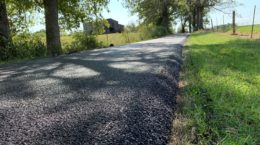Owner/Founder of Blankenship Asphalt Tech and Training gives the low-down on new asphalt product.
Contractors and their crews have a variety of challenges they need to manage when working with asphalt and various modifier additives. From unpleasant odors to cleaning sticky truck beds and ensuring their products meet specifications, paving companies often have their hands full. But thanks to BASF’s B2LAST, contractors have a brand-new tool to help improve operational efficiencies.
To learn more, we spoke with Phil Blankenship, Professional Engineer and founder of consulting engineering company, Blankenship Asphalt Tech and Training, PLLC. Phil has been active in the industry since 1993, holding a variety of roles including Senior Research Engineer for the Asphalt Institute; Project Development Engineer for Koch Pavement Solutions; and Superpave Coordinator and Manager of the Asphalt Binder Laboratory for the Kentucky Transportation Cabinet. He has also been on site, overseeing B2Last trials with BASF. Here’s what he had to say about the revolutionary product.
Q: What makes B2LAST different from other liquid asphalt additives in the marketplace?
B2LAST brings a new type of science from an engineering perspective. We are used to dealing with products that are blended. B2LAST is fully reacted, that means it becomes one with the asphalt – it’s not a two-part system you have to stir all the time. That’s big for contractors because it’s very important they have something that’s easy to handle with no extra work on their end. Once contractors get B2Last modified asphalt into their tank, it is business as usual. B2Last (modifier) also expands the Performance Grade (PG), as other modifiers do, but B2LAST does it in a very different way with new chemistry, and in doing so, creates additional benefits.
Q: What kinds of benefits should the user expect?
Grade expansion. By that, I mean going from a PG 64-22 to a PG 70 or PG 76, for example. It’s very easy to do that with B2LAST. The asphalt suppliers need to meet rigorous compliance tests – AASHTO M320, AASHTO M332 (MSCR) – so being able to meet those specifications becomes critical. If I’m a supplier, I must meet those specification consistently to be in compliance. When you have a product that’s fully reactive, like B2LAST, it breeds consistency in the end product.
Another thing we noticed is that B2LAST does not have sticking issues in the truck bed. It's common for modified mixtures to stick to the corners of a truck and paver. Contractors typically use release agents to combat the sticking, but polymers are designed to be sticky. It is a 2-edged sword as we need adhesion to hold the asphalt mix together. When you raise that truck bed and you’ve got B2LAST, that mixture comes out without any problems. With B2LAST, the adhesion begins after the mix cools. During work temperatures you don’t even know it’s there. But once this product is cool, it is really tight and adhesive. I couldn’t get a rock to budge in the sample that I took during construction. After paving and compaction, we are dealing with a superglue-level product! To restate, with B2Last you get the needed adhesion without the typical construction hassles.
An additional benefit we’ve found is that B2Last reduces odor. Contractors say they like it because it doesn’t smell like other asphalts. Your nose is really sensitive to odors. Whether harmful or not, you don’t want people to work around unpleasant odors, so this was a great finding during the 2019 real-world projects
Q: What applications are best suited to B2Last?
The main use for most asphalts, as with B2LAST, would be the highway pavements – specifically, Interstate- and primary routes. You could use this product on any pavement, but you typically don’t pull out your top-shelf product on rural country roads although that would be nice to have. We haven’t fully explored the limits of this technology yet, but I can see B2Last going into other asphalt related applications that benefit from asphalt modification.
Q: How does this change things from a civil engineering perspective?
From an engineering point of view, one would order a product from a terminal and they would deliver it to my plant. That can be done with B2Last, too. However, with B2last, depending upon the hot mix, the engineer also has the potential to blend this locally at the hotmix asphalt plant. This product is friendly enough that it can be handled locally. The engineers do not need to have large agitators in their tanks to be able to blend B2Last. This is not a product that needs to use high-shear mechanical energy for blending. This is a very friendly product that can be taken right to hot mix plants, if needed, blended/stirred/circulated in a tank, monitored and then, once reacted in that tank, taken direct to the market or the roadway.
BASF Corporation is the largest affiliate of BASF SE and the second largest producer and marketer of chemicals and related products in North America.
To learn more about how B2Last can benefit your asphalt operations please visit the “Contact Us” section of the relevant B2Last website for your region.
For North, Central and South American inquiries please visit: https://b2lastna.basf.com.
For Europe, Asia-Pacific, and Africa please visit www.B2Last.com





